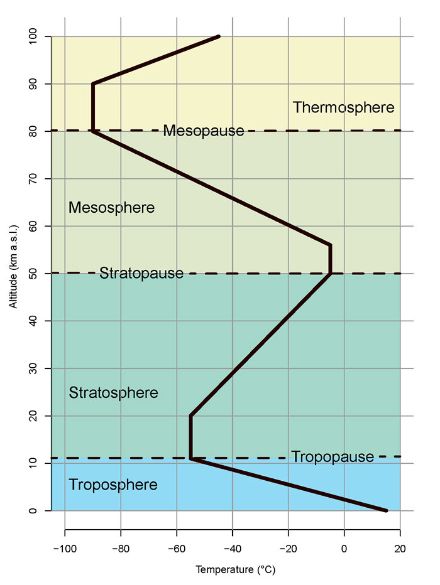Service Navigation
Search
The lowest layer of the Earth’s atmosphere is the troposphere, in which most weather phenomena occur. Depending on the weather situation and the concomitant changes in temperature with altitude, the stratification of the troposphere is either stable, neutral or unstable, and it contains large amounts of water and water vapour. On average, the temperature inside the troposphere decreases with altitude. The extremely dry stratosphere lies above the troposphere, and is characterised by a high ozone content. Ozone absorbs the ultraviolet radiation from the sun, thus warming the stratosphere. As a result, the temperature in the stratosphere increases with altitude, reaching its peak above the ozone layer at around 50 km (at the stratopause). In contrast to the troposphere, this gives the stratosphere a very stable stratification.

The boundary surface between two layers is called the tropopause. The tropopause is always characterised by a marked change in the temperature profile, and represents the lowest temperature between these two layers. Its height depends strongly on the geographical location, the season and the prevalent weather situation. When polar air masses flow into the upper troposphere above Switzerland, this leads to a lowering of the tropopause. Warm air from the subtropics, on the other hand, results in the increased altitude of the tropopause.
The height of the tropopause is significant in aviation. Moreover, processes of exchange between the troposphere and the stratosphere take place at the tropopause that have an impact on the radiation balance of the Earth.
Determining the height of the tropopause
According to the definition of the World Meterological Organisation (WMO), the tropopause height is the lowest level in the atmosphere at which the air cools at a maximum rate of 0.2°C per 100 m of altitude. The definition also specifies that this cooling rate of 0.2°C per 100 m must not be exceeded within a 2-km-thick layer above this level.
As is the case for the zero degree line, the height of the tropopause can also be determined from the temperature profile compiled with the help of weather balloons. In Switzerland, MeteoSwiss conducts weather-balloon soundings at the regional centre in Payerne. Weather balloons are launched twice a day (11:00 AM and 11:00 PM UTC). The average of the tropopause height from both soundings is taken for the daily data.
Annual pattern
The average altitude of the tropopause over the Payerne weather station over the period of 1991-2020 was 11,210 m a.s.l. and the peak altitude of the tropopause at just over 12,000 m occurred in August. In summer, altitudes of over 15 km are possible, whereas an altitude of less than 10 km is rarely seen.
The height of the tropopause is significantly lower in winter and spring. On average, it fluctuates between 10,500 and 11,000 m a.s.l. in the colder half of the year. The tropopause can, however, sink below 10 km for several days at a time in these seasons.
Changes in the tropopause height over the long term
As is the case with temperature, the height of the tropopause over Switzerland is increasing markedly due to climate change. Between 1960 and 2020, the annual average height of the tropopause increased by around 380 m. The trend varies according to the season. The greatest increase during this period can be identified in spring (around 480 m) and summer (around 430 m). The increase in winter is slightly less pronounced, and there is no significant trend identifiable for autumn.
The climate report provides a comprehensive description of the annual cycle of the tropopause height in the previous year, and shows the trends over recent decades